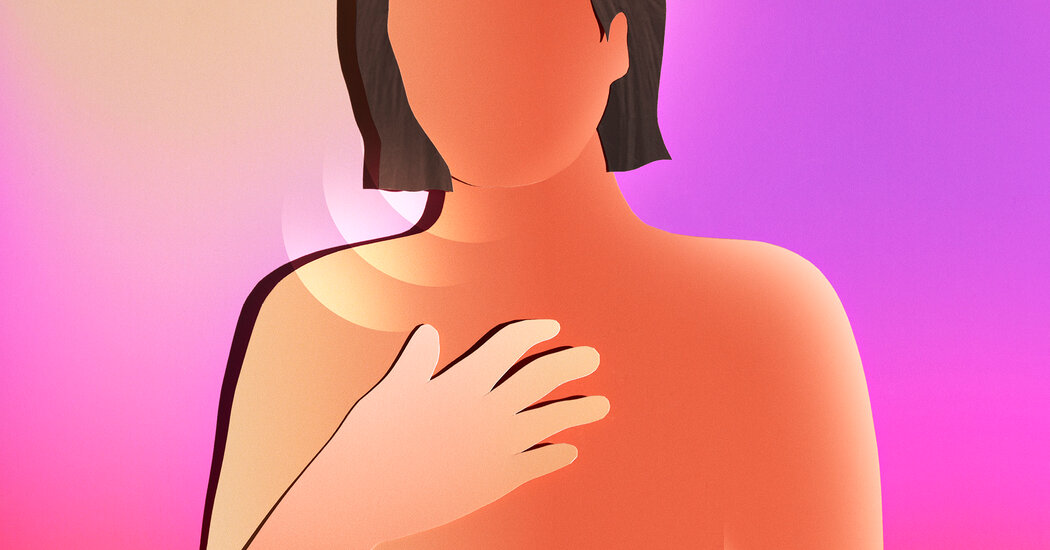The 61-year-old woman lifted the laundry basket and stared grimly at the steps leading up from the basement. The climb seemed to get harder every day. Before climbing halfway, she felt her heart beating wildly and heard the sound of rapid breathing. She clutched the wooden railing in case she started feeling dizzy again. Once on the main floor of her home, she unburdened herself, almost falling into the soft embrace of the living room sofa.
The woman first noticed that she was often out of breath a few months earlier. She wondered if it was her weight. She liked her appearance but doubted that her usual caregiver, a trusted nurse practitioner with a medical team at Yale University School of Medicine, would be happy if she lost a few pounds. Her daughter is concerned that her shortness of breath may be the result of a coronavirus infection she contracted years ago.
She finally called her PCP’s office when her right leg started to hurt. The combination of shortness of breath and leg pain made her nurse practitioner concerned that a blood clot in the patient’s leg had dislodged and lodged in the lung. She sent her for an ultrasound of her legs. There was no clot, which was a relief, but she was still out of breath.
Referral to Long Covid Center
Since then, she’s been doing video consultations seemingly every week. Each visit focuses on the latest of her many different symptoms. For a week, she was so dizzy that she could barely walk. The following week, she shared her concerns about her recent weight loss: 10 pounds in just two weeks. Another time, she saw the doctor who was working with her nurse. As she confronted her across the computer they were connected to, doctors suggested the dizziness might be from not drinking enough water. Her shortness of breath and rapid heart rate may be from lack of exercise. During the next video interview, her nurse practitioner said she probably had POTS — short for postural orthostatic tachycardia syndrome. In this uncommon disorder, people have a fast heart rate, or tachycardia, when they stand up. Sometimes it occurs after a patient has recovered from a Covid infection.
With every new question, there are more tests. She had an ultrasound and a chest x-ray; an echocardiogram that showed her heart was beating normally; and something called a Holter monitor, a wearable device that tracks her heartbeat 24 hours a day, only showed that her heartbeat was sometimes fast . She had an MRI of the brain, a CT scan of her chest, and extensive blood work. After going through it all, the patient was depressed and scared because no one could explain why she suddenly felt so bad in so many ways. She was referred to a neurologist, cardiologist and Yale University’s Long Covid Multidisciplinary Care Center.
She was first seen at the Long Covid Center, where I am the medical director. That April morning, she told me she had been out of breath. She had to quit her job as a cashier. Her eyes sparkle as she describes her rapid decline. Her heart and lungs had been extensively evaluated, with the only abnormality being detected during a Holter monitoring test. Like her Nurse Practitioner, I wondered if she had POTS. Of course, I often see POTS in long Covid patients. A recent study estimated that as many as 14% of patients develop POTS after recovering from Covid-19.
The disorder can be diagnosed using something called an active stand-up test. In this test, the patient monitors heart rate and blood pressure while lying on their back, then stands in place for 10 minutes. POTS is diagnosed when blood pressure remains stable and heart rate increases by at least 30 beats per minute.
When the patient was tested, she became dizzy and out of breath after only a few minutes, and the test had to be stopped early. Her heart rate increased from 101 to 140. POTS is unknown but is thought to indicate impairment of the autonomic nervous system. Normally, standing up triggers a rapid increase in blood flow from the legs and lower body to the heart, where it can be redistributed to the upper body and brain. In POTS, this doesn’t happen, and to get enough blood to the brain, the heart has to beat faster—often much faster. In this patient’s case, as in many others I have seen, the increase in heart rate was insufficient and the patient felt lightheaded. POTS usually appears after a viral infection. While there are medications that can help, the first line of treatment is to increase the amount of water stored in the body and use tights to help flow blood from the lower extremities back to the heart.
I’m not sure if all of this patient’s symptoms are attributable to POTS, but I think treating POTS is the right first step. I encouraged her to drink plenty of water and prescribed her the clothes she needed. Two weeks later, when she reported that her heart was still racing, I started her on medication to slow it down.
She returned to the office a few weeks later. Her heart is better, she tells me, but she’s losing weight: “When I look in the mirror, I can barely recognize my face.” Her normally plump, round cheeks look flat and haggard. She lost 25 pounds in three months. That stopped me. Weight loss is not a common symptom of POTS. Is my diagnosis wrong?
Necessary steps were skipped
Suddenly, her symptoms took on a completely different shape. I have been making assumptions about her condition based on the fact that the doctor who referred her to our center believes her symptoms are the result of long term Covid. But in fact, none of us know if she has long-term COVID-19. There is no definitive test that can link current symptoms to a Covid infection experienced weeks, months or even years ago. In April 2020, months after the virus arrived in the United States, the first reports of symptoms lasting longer than viral infection were published. Since then, various symptoms have appeared. But the link between the symptoms and the supposed cause is temporary. Only patient experience suggests a link exists. But for many disorders without definitive tests, a diagnosis can only be made after other possibilities have been ruled out. In seeing this patient, I skipped that important step.
This is a middle-aged woman with a racing heart, shortness of breath with exertion, and rapid weight loss—typical of an overloaded thyroid hormone, a condition called hyperthyroidism. This tiny gland in the neck is part of a complex system that controls the body’s metabolism. When too much thyroid hormone is released, the body’s engine revs like someone stomped on the gas pedal. She had all the symptoms of hyperthyroidism and I just didn’t see it. I sent her to the lab down the hall from my office. Within hours, it was clear that her system was flooded with these hormones.
I immediately called the patient and explained that despite the positive voluntary standing test, she probably did not have POTS and instead her thyroid was out of control. This is often the result of an autoimmune disorder called Graves’ disease, in which antibodies bind to thyroid receptors, mistaking these normal cells for attacking invaders and triggering a near-continuous release of their hormones . Even before Graves’ diagnosis was confirmed, the patient began taking drugs to block the hormone’s production.
For the past 20 years, I’ve been writing and thinking about diagnostic errors. I understand how this happens. In medicine, most diagnoses are made through a process of identification. We see something, recognize it and act on what we see. Most of the time we are right. most of the time. I asked the patient for a photo to put on my desk. I wish to remind you that the first diagnosis that comes to mind is never the only one considered.
As for the patient, she feels much better since starting these medications. Her heart rate dropped, and the basement stairs were getting easier. She told me she’s stopped losing weight, but she won’t feel like her old self until her cheekbones are hidden again.
Lisa Sanders, MD, is a staff writer for the journal. Her latest book is “Diagnosis: Solving the Most Confusing Medical Mysteries.” If you have a solved case to share, please write her at Lisa.Sandersmdnyt@gmail.com.


